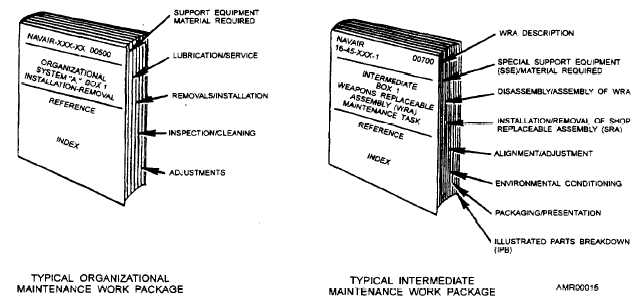present three levels (organizational, intermediate, and
depot), new maintenance techniques evolved. System
testing and the use of hot benches started to disappear
in favor of specialized test simulators for components
and equipment. Unique fault isolation and rapid-fix
techniques were developed at intermediate and depot
levels. This was based on an “inspect and repair as
necessary” unit concept. A reduction in maintenance
costs and pipeline turnaround was the goal.
Organizational flight deck/line troubleshooting
remained on a system basis. The increases in installed
systems and equipment complexity reduced flight-line
maintenance to component-fault isolation and unit
replacement. Technical manuals had to reflect these
new practices to support aircraft turnaround-time
limitations.
Conventional manuals have reached the limits of
their expansion. This format that has served so well
c a n n o
longer cope with new designs.
Microminiaturization, computerization, integrated
weapons systems design, and the introduction of
microfilm media dictated the development and
introduction of new formats and presentation methods.
This resulted in the work package concept.
Work Package (WP) Technical Manual
Arrangement. The complexity of weapons system
design has made the technician more dependent on
publications. To improve technical information,
publications place emphasis on data accessibility,
adequacy, accuracy, and overall documentation
usability. The limited viewing range imposed by
microfilmed manuals adds further demands for data
presentation improvements. In addition, manuals must
be compatible to both paper and film.
Investigation of publication requirements,
primarily through fleet visits, confirms that usability
is the key. The value of information is limited if it is
difficult to use. The usability of a manual has three
primary elements-visible lock-on format, logical
arrangement structure, and quick understanding or
comprehension.
Q3. What are the two general styles of technical
manuals?
Q4. Technical manuals are divided into how many
major types and what are they?
Q5. How are workpackage (WP) manuals divided?
Q6. What are the three primary elements for usability
in a manual?
Format Considerations. Text for microfilm
emphasizes coordination between text and
illustrations, line art instead of photographic art for
illustration legibility, and a comprehensive index for
many points of entry.
Logical Arrangement. Data is screened and
consolidated to make it easier to find units of
information within the manual. The units of
information are arranged sequentially by functions and
tasks. Each unit is also written to stand alone as an
individual maintenance unit that contains all the data
required for task performance. See figure 2-2.
Figure 2-2.—Work package (WP) arrangement data consolidation for organizational and intermediate maintenance.
2-3

